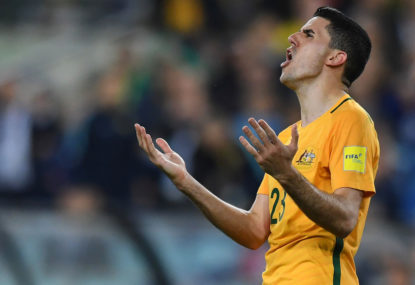The Australian Under 23s are returning home from the AFC Championships in China, having finished third in their group – ahead of Syria, but behind South Korea and Vietnam.
They lost to both the teams ahead of them, and in both matches, the Aussies had 69 per cent or more of the possession, and attempted at least double the amount of passes as their opponents.
Preoccupied with keeping possession and building slowly and methodically, the result was, in consecutive games, defeat to a team that defended deeply and with grit, and struck on the break.
The Australians actually made more than three times the Vietnamese’s amount of passes and had 75 per cent of possession in that 0-1 defeat, a result that may not have been so surprising to those who have kept a keen eye on the two generations of players that took to the pitch.
To others, it was a galling, embarrassing outcome.
Having beaten Syria 3-1 in their opening game, all that it would have taken for Australia to qualify for the next stage was a draw against the Vietnamese – in the end it was against Australia that they registered their only win, and a 0-0 draw against the Syrians was enough to take Vietnam through.
In the match against Vietnam, Paul Izzo was forced to address five Vietnamese attempts on his goal. Bui Tien Dung, his opposite number, faced five shots as well. Australia lashed a further eight shots off-target, to Vietnam’s two off-target shots, most of them from inside the box.
So, the story drawled on in a tediously familiar manner; not just the lion’s share, but the lioness’s, cub’s, hyena’s and Zanzibar Bushbaby’s share of possession too – but precious little cutting edge in the final third.
90 minutes of attractive impotence, against a stolid Asian opponent, that ends with a highly underwhelming result. We’ve seen this before.
Against South Korea, the Australians spanked in many more shots from distance (seven of 13 totals shots), as the Koreans – four ranged attempts out of 11 total shots – wound their way into Izzo’s penalty area time after time on the counter. Two thirds of possession, twice the passes, and – having been 2-0 down at halftime – Australia lost 3-2.
Both the Koreans and the Vietnamese anticipated Australia would hog the ball, take their time, but ultimately fall short in attack, and they set up to exploit this. Just like Thailand did against the Socceroos. And Japan. And Syria.
[latest_videos_strip category=”football” name=”Football”]
A footballing revolution doesn’t happen overnight. No one should be making an argument fervently against teaching young players to value possession, to look for the simple pass, to arrange themselves into passing triangles off-the-ball, to harbour aspirations of playing like peak Barcelona.
But there has to be a balance, one that allows us to play to our existing strengths – or, indeed, mask our weaknesses – especially in vital matches, even if they are unpalatable within the wider philosophy. It isn’t a bad idea to rouse the pragmatic side of ourselves when we have to.
When the Socceroos lost 2-0 to Japan in late August, they were skewered by a team who gave up the ball, defended well, and plundered on the break. Then they narrowly defeated Thailand 2-1 in early September, failing to score freely against a team that employed a near-identical strategy to that of the Japanese, and as a result thwarted what should have been a night to celebrate for the Roos.

AP Photo/Andy Brownbill
Did Australia change their approach for that second game against Thailand, knowing they’d probably play that way heading in? Not really, and it then took four more nerve-shredding matches to make up for it.
The complaints were that the Roos didn’t have the skilled personnel to play effectively in the way they wanted to, and – if we take the recent tournament exit as any indication – it seems the younger generation have been found wanting in the same areas.
If we haven’t the incision in attack, or the imagination in midfield, or the versatility in defence to play a possession-heavy, patient style, then what should we do? This is a question that will be pondered by the next Socceroos manager, and he may well initiate a departure from the course we’ve been plotting these last few years.
If we enter Russia 2018 as a muscular, vertical, counter-attacking side, Mathew Leckie locked-and-loaded to race down the flanks, Mile Jedinak ready to bang in the midfield, and Matt Ryan clearing his lines, would this be a bad thing? Would it more likely to bring us success against Denmark, or Peru?
Over the last nine months, the standout Socceroos performance – save for the absolutely cathartic clinching second-leg match against Honduras – was the rollicking 1-1 draw with Chile in the Confederations Cup. There, the Roos had less of the ball, made fewer passes and more fouls than their opponent, and generally hared around the midfield like crazed loons, intent on, if nothing else, making clear the exact capacity of their lungs and extent of their will.
Yes, we allowed the Chileans five shots on target, and leaned heavily on the stopping skills of Ryan, but so what? Against Japan, a month later, we made nearly 250 more passes than we had against Chile, with more possession, and still allowed the keeper to be peppered with shots.
Which was the preferable results – or performance – out of those two matches?
So, the younger generation, still malleable and fragile, will have to recover from this disappointment. We did make the World Cup, eventually, and the AFC U-23 Championships aren’t all that important, in the grand scheme of things.
Still, Australian football’s on-field identity is yet to shape itself into a comfortable image.






























































































